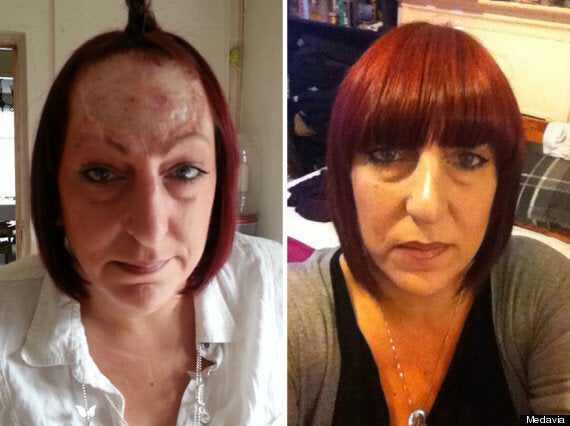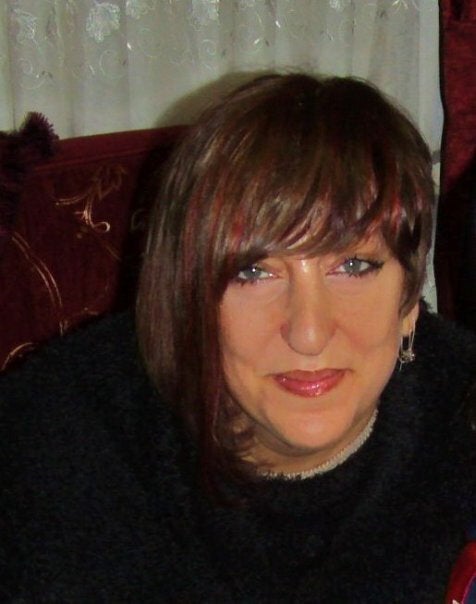WARNING: GRAPHIC IMAGES
A ‘one-in-a-million’ cancer patient whose entire forehead was removed is inviting other people with her extremely rare condition to connect with her online.
Pip Caliskan, 45 has worn a prosthetic beneath her fringe since her forehead was surgically removed in 2008 to combat a spreading dermatofibrosarcoma protuberans (DFSP) growth.
Although DFPS is rarely fatal, tumours are notoriously difficult to eradicate. During treatment patients often have large amounts of tissue surrounding the growth removed, leading to noticeable scarring.

In Mrs Caliskan’s case surgeons were forced to remove 85% of the thickness of her skull bone.
She said: “I walk around for most of my life making sure I cover up my forehead. I’m very self conscious and get very paranoid about it. Every so often I scratch some skin away from the graft, exposing some bone.
“But I want to be very open about DFSP, because it’s not a condition which is widely understood.
“It’s considered a good cancer to have because it rarely spreads to other parts of the body. It’s not a big killer. But the effect it has is quite devastating. It needs dramatic treatment.
“I am now in touch with hundreds of people from all over the world who have experienced the condition and at least 80 per cent of them carry significant scars.”
Story continues below...
Mrs Caliskan, of Bushey Heath, Hertfordshire, was diagnosed in 1996 after she had been bothered by a bump in the middle of her hairline for several months.
She said: “The doctor said it was a cyst and suggested I leave it alone. Such things usually go away on their own and are usually harmless. So I left it for six months.
“But it just got bigger, so I asked for it to be removed. The procedure was meant to be quite simple - a quick surgery and a couple of stitches.
“I got a phone call two weeks later to say tests had come back and had confirmed I had cancer.
“I was 27 years old and I didn’t have a clue what lay ahead.”
She was told her tumour consisted of spindles of cancerous cells spreading across her forehead. Surgery would be required, and if surgeons left just one cancerous cell on her head, it could develop into a new tumour.
She underwent two rounds of surgery in 1996 and 1998.
Then, in 2008, as she was about to celebrate ten years of living cancer-free, the tumour returned.
She said: “The surgeon left just 15 per cent of the thickness of my skull bone. I’ve got no muscle, nerves, soft tissue on my forehead. There’s nothing left. Over the top they laid animal collagen, and I had a skin graft over that.
“I now wear an NHS prosthetic under my hair to protect it, but I always need to be quite careful.”
Also On HuffPost UK Lifestyle:
Chinese Man Has 13Kg Tumour Removed From His Back In Nine-Hour Operation
Woman Left With Sagging Boobs And Rotting Fat Warns Against Sloppy Plastic Surgery Abroad
Mrs Caliskan, a former nail technician who was supported through her recovery by her daughter Leah, 22, and her husband Aydin, 30, is now in remission but stays vigilant against the cancer returning.
She is the founder of a Facebook hub for people who have been diagnosed with DFSP and are looking for answers.
Patients often arrive at her group, which she launched in 2008, feeling confused and isolated. The extreme rarity of the condition - which presents in around one case per million people - means patients often don’t know where to begin looking for support and information.
Mrs Calliskan said: “When I was first diagnosed we didn’t have laptops or smartphones. Finding information felt like an uphill struggle.
“So when the cancer came back I decided to launch a group to reach out to other people who might benefit from hearing about others’ experiences. For the first six months I was the only member. Then, a very anxious young woman from America found me and told me she had just been diagnosed.
“Now we have nearly 600 members and I’m assisted by administrators from America, Canada and Australia.
“Beyond a shadow of a doubt we have collected the biggest volume of information and personal accounts. Collectively we have access to more knowledge and information than any one doctor or hospital anywhere in the world. I feel very glad to be part of a group like that.”
The group, which is named ‘dfsp - DERMATOFIBROSARCOMA PROTUBERANS’ on Facebook, is currently planning awareness-raising through the design of a lapel ribbon and is seeking official charity status.
And in August, Mrs Caliskan will welcome two fellow DFSP patients to the UK.
She said: “It’s an amazing feeling, as a one-in-a-million case, to meet another one-in-a-million case. You don’t feel as alone. I’ve made some amazing friends through the group.”
For more info on DFSP, find them on Facebook or email
